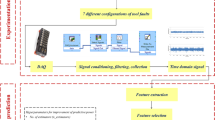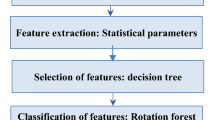Abstract
In precision manufacturing, tool condition monitoring is critical for improving surface finish, increasing efficiency, and lowering manufacturing costs. The present work discusses a complete workflow to accurately predict the tool condition based on vibration data obtained during the turning operation performed on a lathe. An image processing methodology is applied to compute the tool wear area. A specialized misclassification cost matrix is used to train the random forests algorithm to improve the classification of tool conditions. This model can correctly classify tool condition from vibration signals of 0.5 s with an accuracy of 97%. Furthermore, this investigation can be modified to suit the real-world classification of the tool condition based on tool wear requirements.













Similar content being viewed by others
References
Wang S, Wan J, Zhang D, Li D, Zhang C (2016) Towards smart factory for industry 4.0: a self-organized multi-agent system with big data based feedback and coordination. Comput Networks 101:158–168. https://doi.org/10.1016/j.comnet.2015.12.017
Huang Z, Zhu J, Lei J, Li X, Tian F (2021) Tool wear monitoring with vibration signals based on short-time Fourier transform and deep convolutional neural network in milling. Math Probl Eng 2021:1–14. https://doi.org/10.1155/2021/9976939
Siddhpura A, Paurobally R (2013) A review of flank wear prediction methods for tool condition monitoring in a turning process. Int J Adv Manuf Technol 65(1–4):371–393. https://doi.org/10.1007/s00170-012-4177-1
D. Dimla, ‘Sensor signals for tool-wear monitoring in metal cutting operations—a review of methods’, Int. J. Mach. Tools Manuf., vol. 40, no. 8, pp. 1073–1098, 2000, [Online]. Available: http://linkinghub.elsevier.com/retrieve/pii/S0890695599001224.
Serin G, Sener B, Ozbayoglu AM, Unver HO (2020) Review of tool condition monitoring in machining and opportunities for deep learning. Int J Adv Manuf Technol 109(3–4):953–974. https://doi.org/10.1007/s00170-020-05449-w
Sick B (2002) Online and indirect tool wear monitoring in turning with artificial neural networks: a review of more than a decade of research. Mech Syst Signal Process 16(4):487–546. https://doi.org/10.1006/mssp.2001.1460
Wang W, Wong YS, Hong GS (2005) Flank wear measurement by successive image analysis. Comput Ind 56(8–9):816–830. https://doi.org/10.1016/j.compind.2005.05.009
S. Dutta, S. K. Pal, and R. Sen, Digital Image Processing in Machining, no. January 2014. 2014.
Lanzetta M (2001) A new flexible high-resolution vision sensor for tool condition monitoring. J Mater Process Technol 119(1–3):73–82. https://doi.org/10.1016/S0924-0136(01)00878-0
Sortino M (2003) Application of statistical filtering for optical detection of tool wear. Int J Mach Tools Manuf 43(5):493–497. https://doi.org/10.1016/S0890-6955(02)00266-3
Fadare DA, Oni AO (2009) Development and application of a machine vision system for measurement of tool wear. J Eng Appl Sci 4(4):42–49
R Schmitt, Y Cai, and A Pavim (2012) ‘Machine vision system for inspecting flank wear on cutting tools’, ACEEE Int. J. Control Syst. Instrum, 03(01): 27–31. 01.IJCSI.03.01.13.
Kerr D, Pengilley J, Garwood R (2006) Assessment and visualisation of machine tool wear using computer vision. Int J Adv Manuf Technol 28(7–8):781–791. https://doi.org/10.1007/s00170-004-2420-0
Castejón M, Alegre E, Barreiro J, Hernández LK (2007) Online tool wear monitoring using geometric descriptors from digital images. Int J Mach Tools Manuf 47(12–13):1847–1853. https://doi.org/10.1016/j.ijmachtools.2007.04.001
Alegre E, Alaiz-Rodríguez R, Barreiro J, Ruiz J (2009) Kulumisjälje kontuuride kasutamise ja klassifitseerimise meetodid metallide lõiketöötlemisel püsivusaja optimeerimiseks. Est J Eng 15(1):3–12. https://doi.org/10.3176/eng.2009.1.01
Sun WH, Yeh SS (2018) Using the machine vision method to develop an on-machine insert condition monitoring system for computer numerical control turning machine tools. Mater 11(10):1977. https://doi.org/10.3390/ma11101977
Salgado DR, Alonso FJ (2006) Tool wear detection in turning operations using singular spectrum analysis. J Mater Process Technol 171(3):451–458. https://doi.org/10.1016/j.jmatprotec.2005.08.005
Jiang X, Shen C, Shi J, Zhu Z (2018) Initial center frequency-guided VMD for fault diagnosis of rotating machines. J Sound Vib 435:36–55. https://doi.org/10.1016/j.jsv.2018.07.039
Saglam H, Unuvar A (2003) Tool condition monitoring in milling based on cutting forces by a neural network. Int J Prod Res 41(7):1519–1532. https://doi.org/10.1080/0020754031000073017
Huang SN, Tan KK, Wong YS, de Silva CW, Goh HL, Tan WW (2007) Tool wear detection and fault diagnosis based on cutting force monitoring. Int J Mach Tools Manuf 47(3–4):444–451. https://doi.org/10.1016/j.ijmachtools.2006.06.011
Sundaram S, Senthilkumar P, Kumaravel A, Manoharan N (2008) Study of flank wear in single point cutting tool using. Network 3(4):32–36
Hsieh WH, Lu MC, Chiou SJ (2012) Application of backpropagation neural network for spindle vibration-based tool wear monitoring in micro-milling. Int J Adv Manuf Technol 61(1–4):53–61. https://doi.org/10.1007/s00170-011-3703-x
Krishnakumar P, Rameshkumar K, Ramachandran KI (2018) Machine learning based tool condition classification using acoustic emission and vibration data in high speed milling process using wavelet features. Intell Decis Technol 12(2):265–282. https://doi.org/10.3233/IDT-180332
Nguyen VT, Nguyen VH, Pham VT (2020) Deep stacked auto-encoder network based tool wear monitoring in the face milling process. Stroj Vestnik/Journal Mech Eng 66(4):227–234. https://doi.org/10.5545/sv-jme.2019.6285
Dai L et al (2020) An improved deep learning model for online tool condition monitoring using output power signals. Shock Vib 2020:1–12. https://doi.org/10.1155/2020/8843314
Zhao R, Yan R, Wang J, Mao K (2017) Learning to monitor machine health with convolutional Bi-directional LSTM networks. Sensors 17(2):1–18. https://doi.org/10.3390/s17020273
Kwon Y, Fischer GW (2003) A novel approach to quantifying tool wear and tool life measurements for optimal tool management. Int J Mach Tools Manuf 43(4):359–368. https://doi.org/10.1016/S0890-6955(02)00271-7
Breiman L (2001) Random forests. Mach Learn 45(1):5–32. https://doi.org/10.1023/A:1010933404324
A Cutler, DR Cutler, and JR Stevens (2012) ‘Ensemble machine learning’. Ensemble Mach. Learn. https://doi.org/10.1007/978-1-4419-9326-7
Ali J, Khan R, Ahmad N, Maqsood I (2012) Random forests and decision trees. Int J Comput Sci Issues 9(5):272–278
Abhang LB, Hameedullah M (2012) Optimization of machining parameters in steel turning operation by Taguchi method. Procedia Eng 38:40–48. https://doi.org/10.1016/j.proeng.2012.06.007
Sikdar SK, Chen M (2002) Relationship between tool flank wear area and component forces in single point turning. J Mater Process Technol 128(1–3):210–215. https://doi.org/10.1016/S0924-0136(02)00453-3
Thakre AA, Lad AV, Mala K (2019) Measurements of tool wear parameters using machine vision system. Model Simul Eng 2019:1–10. https://doi.org/10.1155/2019/1876489
Sun Y, Wong AKC, Kamel MS (2009) Classification of imbalanced data: a review. Int J Pattern Recognit Artif Intell 23(4):687–719. https://doi.org/10.1142/S0218001409007326
Jiang Y, Cukic B (2009) Misclassification cost-sensitive fault prediction models. ACM Int Conf Proceeding Ser. https://doi.org/10.1145/1540438.1540466
He K, Gkioxari G, Dollár P, Girshick R (2020) Mask R-CNN. IEEE Trans Pattern Anal Mach Intell 42(2):386–397. https://doi.org/10.1109/TPAMI.2018.2844175
Author information
Authors and Affiliations
Corresponding author
Ethics declarations
Competing interests
The authors declare no competing interests.
Additional information
Publisher's note
Springer Nature remains neutral with regard to jurisdictional claims in published maps and institutional affiliations.
Rights and permissions
Springer Nature or its licensor (e.g. a society or other partner) holds exclusive rights to this article under a publishing agreement with the author(s) or other rightsholder(s); author self-archiving of the accepted manuscript version of this article is solely governed by the terms of such publishing agreement and applicable law.
About this article
Cite this article
Cardoz, B., Shaikh, H.N.E., Mulani, S.M. et al. Random forests based classification of tool wear using vibration signals and wear area estimation from tool image data. Int J Adv Manuf Technol 126, 3069–3081 (2023). https://doi.org/10.1007/s00170-023-11173-y
Received:
Accepted:
Published:
Issue Date:
DOI: https://doi.org/10.1007/s00170-023-11173-y




